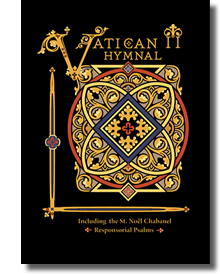Have you heard of the Vatican II Hymnal? Here’s a
description from the publisher:
750 PAGES LONG • COMPLETE READINGS
FOR ALL SUNDAYS AND MAJOR FEASTS FOR YEARS A, B, & C • FIRST HYMNAL EVER PRINTED
TO CONTAIN COMPLETE TEXTS FOR THE SUNG PROPERS • MORE THAN A HUNDRED PAGES OF MASS
SETTINGS USING THE NEW TRANSLATION OF THE ROMAN MISSAL • COMPLETE TEXTS IN LATIN
AND ENGLISH FOR BOTH FORMS OF THE MASS (ORDINARY & EXTRAORDINARY) • BEAUTIFUL
HYMNS, INCLUDING MORE THAN 100 PAGES OF COMMUNION HYMNS • SAINT NOËL CHABANEL RESPONSORIAL
PSALMS, GARNIER ALLELUIAS, AND MUCH MORE
You can see some sample pages here.
You can see some sample pages here.

Crisis
Magazine recently ran an article reviewing the Vatican II Hymnal, entitled “Some
New Church Music That Isn’t Sickening”, by Daniel Lord. Read the whole
thing there, but here’s an excerpt to whet your appetite:
A New Kind of Hymnal
This is not another article
about bad liturgical music. It is more of a clarion call to embrace a better
way of performing and participating in the music of Mass. The recently released
Vatican II
Hymnal, published by the Texas-based non-profit organization Corpus Christi
Watershed, is the pièce de résistance of this “better way.”
…
The Church put specific prayers
and chants in place for every Mass many centuries ago, with the intention that
we should sing them regularly and ritually: an Introit at the beginning, a
Gradual and an Alleluia after the readings, an Offertory and a Communion.
Each is an exquisite gem that
inspires everyone who hears. Each bears an aura of antiquity that is
astounding: many of them would have been heard and sung by St. Thomas Aquinas,
St. Francis of Assisi, and St. Albert the Great.
The Church prefers that we use
these chants today, and yet most of us have never heard them before. The
Catholic Church does allow for some latitude in the music planned for Mass, but
what was intended as an extraordinary exception has become a universal rule.
Sunday Mass is now dominated by songs which are quite often musically inferior, thematically
inappropriate, and lyrically shallow. The result is a lack of unity in God’s
family and a watering down of the Mass’s inherent beauty.
How can a parish make the switch to chant?
“I would suggest a two-step
program,” [CCW President Jeffrey Ostrowski] says. “Firstly, every secular,
undignified, emotionally-driven song needs to be gradually banished from our
churches. Secondly, we ought not to instantly take away hymns, because we have
become so accustomed to them—and many are truly beautiful and they enhance
worship. However, we should remember that chanting, especially the Mass Propers, is our ultimate
goal.”
“Musicologists,” he goes on to
say, “have pointed out that the very form of metrical hymns, with their
predictable upbeat and downbeat, tend to remind us of the passage of time and
(by extension) the world. Whereas Gregorian chant, which is completely free in
its rhythm, takes you into another world: prayerful, reverent, eternal, holy.”
On top of this, it is the
preferred music of the Church—not the hymns to which we have all become so
accustomed. Gregorian chant “should be given pride of place in liturgical
services,” wrote the Council Fathers in 1963’s Sacrosanctum Concilium
(par. 116) and yet this mandate has largely been ignored for decades.
The article concludes with this paragraph:
The Vatican II Hymnal,
like everything Corpus Christi Watershed produces, is done with no other
purpose in mind than to bring us all into closer contact with God and with each
other at Mass. It is high time that music directors stop thumbing through
missalettes in search of mediocre songs that may or may not be prescribed by
the Church. It is time to rediscover the ancient glory of the chants that the
Church gives us.
Read the whole article here.
No comments:
Post a Comment